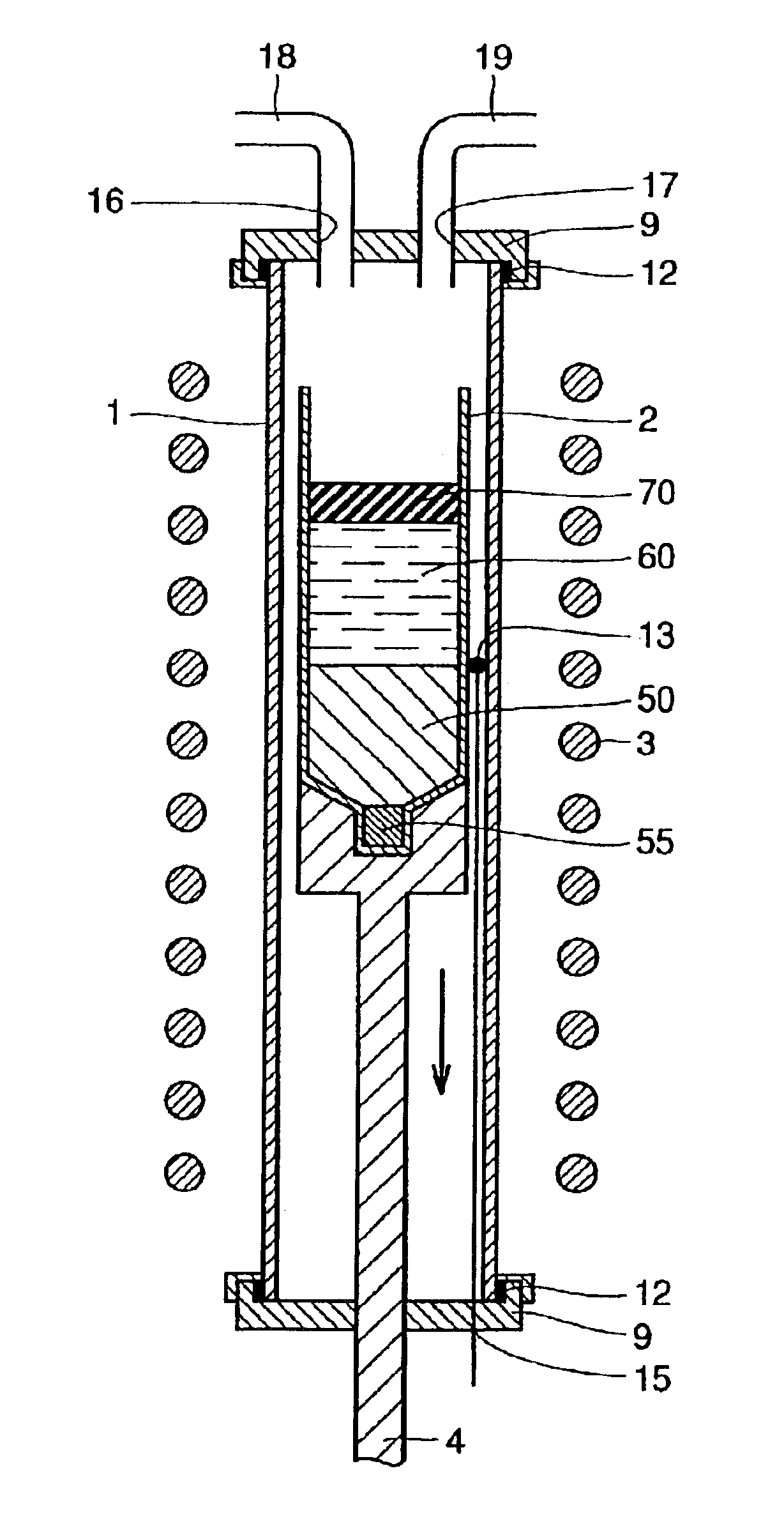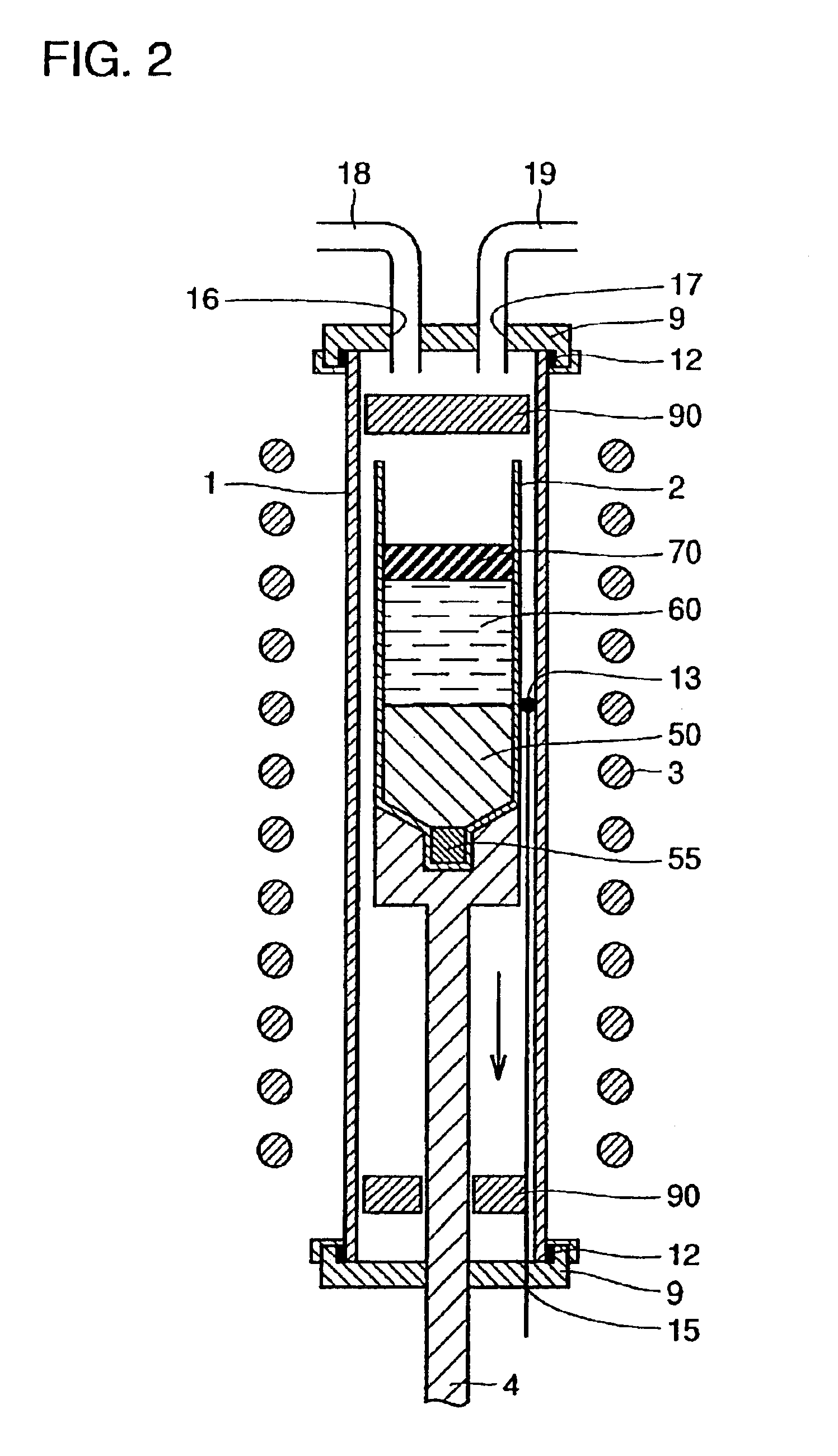Large size semiconductor crystal with low dislocation density
a technology of dislocation density and large semiconductor crystal, which is applied in the direction of crystal growth process polycrystalline material growth, etc., can solve the problems of large compound semiconductor crystal production, large furnace size, and inability to produce large compound semiconductor crystal greater than 4 inches, so as to reduce the activation factor and reduce the residual strain , the effect of improving the device performan
- Summary
- Abstract
- Description
- Claims
- Application Information
AI Technical Summary
Benefits of technology
Problems solved by technology
Method used
Image
Examples
first embodiment
FIG. 1 is a sectional view of the schematic structure of an apparatus of producing a semiconductor crystal according to a first embodiment of the present invention.
Referring to FIG. 1, the apparatus includes a silicon carbide reactor tube 1 and a kanthal heater 3. Silicon carbide reactor tube 1 has an inner diameter of 170 mm and a thickness of 3 mm with an open end at both end sides. Kanthal heater 3 is arranged around reactor tube 1 in the atmosphere with 5 zones.
The first embodiment is characterized in that the heater is not externally shielded, as shown in FIG. 1. According to the conventional LEC method as disclosed in the aforementioned Japanese Patent Laying-Open No. 2-233578, a carbon heater of low reactivity was used to grow a crystal within a high pressure chamber. In contrast, the first embodiment of the present invention has a heater provided in the atmosphere outside the reactor tube. Therefore, a heater based on iron and the like that is low in cost can be used. This t...
second embodiment
FIG. 8 is a sectional view showing a schematic structure of an apparatus of producing a semiconductor crystal according to a second embodiment of the present invention. The reactor tube of the second embodiment is formed of aluminum nitride.
Referring to FIG. 8, the apparatus has kanthal heater 3 of five zones divided into the upper one zone and the lower four zones by the interposition of a heat insulator 8. Heat insulator 8 is provided also inside aluminum nitride reactor tube 1 corresponding to the height of heat insulator 8 provided between the heater.
Crucible 2 is placed within aluminum nitride reactor tube 1 at the position lower than heat insulator 8. A reservoir 6 is placed in aluminum nitride reactor tube 1 at a position upper than heat insulator 8. A pipe 7 is connected to reservoir 6. Pipe 7 is formed so that the leading end is located in material melt 60 that is charged into crucible 2.
The remaining structure is similar to that of the apparatus of the first embodiment sho...
third embodiment
FIG. 12 is a sectional view showing a schematic structure of an apparatus of producing a semiconductor crystal according to a third embodiment of the present invention. The reactor tube of the present embodiment is formed of aluminum oxide.
The apparatus of FIG. 12 is mainly used in the pulling method. The apparatus includes an aluminum oxide reactor tube 1 having an open end at both end sides, and a heater 3 arranged around aluminum oxide reactor tube 1. A flange 9 is attached at both the open ends of aluminum oxide reactor tube 1.
Lower shaft 4 pierces the center of the flange 9 attached at the lower end of aluminum oxide reactor tube 1. Crucible 2 is mounted at the leading end of lower shaft 4. A pull shaft 14 that is movable upwards and downwards pierces the center of flange 9 attached at the upper portion of aluminum oxide reactor tube 1. A crystal is grown by drawing up pull shaft 4 in the direction of the arrow.
The apparatus of the present embodiment includes an aluminum oxide ...
PUM
| Property | Measurement | Unit |
|---|---|---|
| diameter | aaaaa | aaaaa |
| diameter | aaaaa | aaaaa |
| thickness | aaaaa | aaaaa |
Abstract
Description
Claims
Application Information
 Login to View More
Login to View More - R&D
- Intellectual Property
- Life Sciences
- Materials
- Tech Scout
- Unparalleled Data Quality
- Higher Quality Content
- 60% Fewer Hallucinations
Browse by: Latest US Patents, China's latest patents, Technical Efficacy Thesaurus, Application Domain, Technology Topic, Popular Technical Reports.
© 2025 PatSnap. All rights reserved.Legal|Privacy policy|Modern Slavery Act Transparency Statement|Sitemap|About US| Contact US: help@patsnap.com



